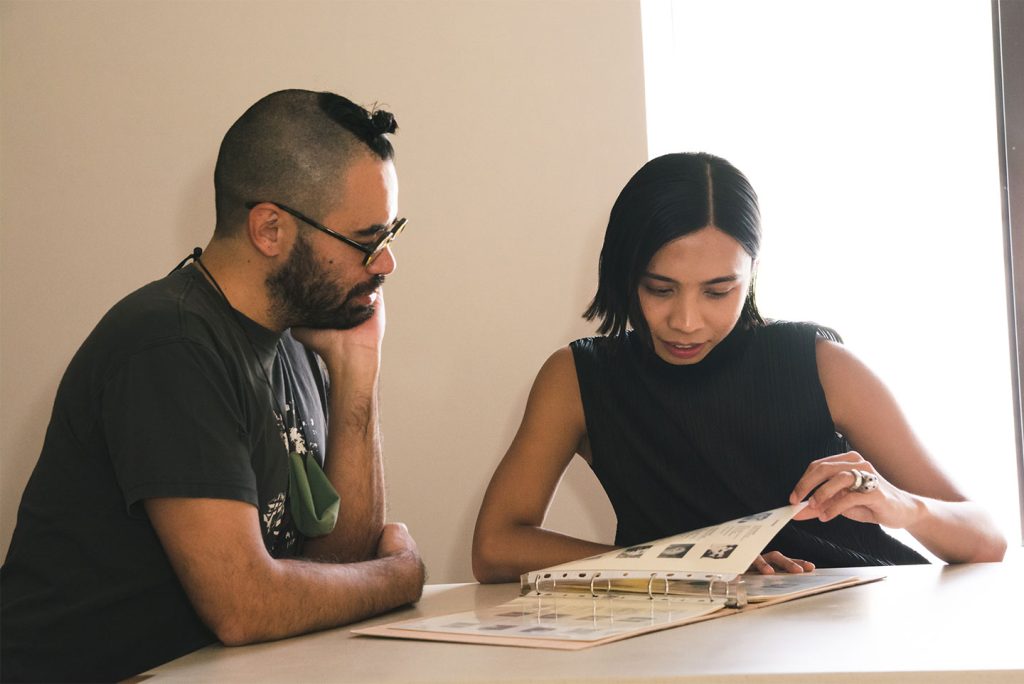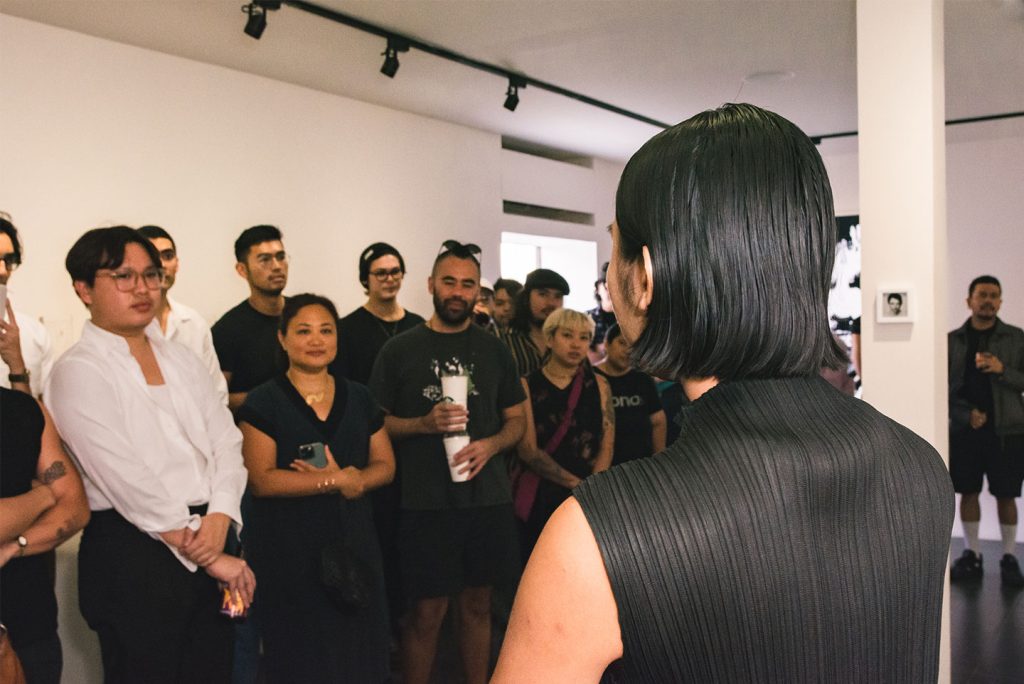MANILA, PHILIPPINES — What does it mean to process a loss? With the vast array of human experiences that have encountered it, there’s no one set mechanism by which people do so. But, in the case of “Willing the Sun to Rise Twice,” this foray into processing loss is done through literal, technical processing via artificial intelligence (Al).

“Willing the Sun to Rise Twice” is the latest exhibit by multidisciplinary artist Jao San Pedro in which her endeavor to reconstruct her first love starts by using his final voice message to her as the primary input for what becomes a chain of generative Al processes.
In a chat with adobo Magazine, Jao sat down to talk about her creative process, giving a look into the steps and layers of generation — and inevitable loss — that make “Willing the Sun to Rise Twice” an effective meditation on grief, liminality, and the act of gaining control of that experience.


Setting off the chain of loss
The attempt at reconstituting her lost love starts with a 25-second voice message — the last one she received from him. According to Jao, the choice to start with something so personal and so purely her ex-lover as the first input of this string of generation — which ends up producing results that become more and more removed from him – stemmed from the desire to create something still driven by emotion.

“[This exhibit] is the first time that I wanted the actual feeling to be felt. I have a tendency to sterilize or make things a little too clean,” she explained. “I wanted the feeling to be the main driver [while also] abstracting that feeling over and over.”
Because the generator needed 30 minutes worth of input to learn and clone a voice, Jao had to loop it until it was able to clone his voice and generate a four-sentence transcript. And, here, the abstraction starts.
“He has a very distinct Italian accent, which the generator can confuse,” she said. “[So,] within the transcription, there’s already loss because of his accent.”
To create more text out of it, she then fed the transcript into two new text generators over and over again until the generators started to confuse themselves and, eventually, began admitting their limitations as Al.

“It’s really poetic that the Al started to apologize that it could no longer reconstitute my love” she recalled. “In the end, it also encouraged me to forget both the Al and the man and expand myself through technology.”
Despite the generator’s advice, though, the process carried on. Jao proceeded to feed all the text generated from the back-and-forth use of the generators to the voice clone and finally heard it – a recording that was meant to be the ex-lover’s voice.
“It was a surreal experience. There’s a certain static and inferences within the voice because of the lack of data, but every now and again, [the clone] would say a word that pops,” she shared. “His actual voice pops. [Also,] the more you listen to [the whole thing,] it actually sounds more and more like him.”
Mirror: Lover is the first thing you hear in the exhibit, and from there, she wanted to grow the process of reconstitution. She did this through semantic fingerprinting, through which a generator turned the words from Mirror: Lover into keywords that were then constellated within a grid, which became the next work in the exhibition, Dial.



The semantic fingerprints were then fed into a generator that generated 100 portraits – some more “realistic” than the others, some more glitchy, some more amorphic – in the quest to find his likeness among the collection (to no avail.)
The chain continues from there. Each new piece was the new input to be fed into another generator. The portraits were used as the input to generate a new voice, which was then used to generate a moving image. And with each step, the structure dissipates further. The further the attempt goes, the more loss she encounters.
But that is exactly what drives home the point of “Willing the Sun to Rise Twice.” The show was never meant to be about the capabilities of Al. It was never meant to display the success of generative technology. Rather, the Al’s failure to reconstitute the ex-lover is what makes this exhibit what it is.
“[Because of the accessibility of the generators I used,] anyone can do exactly what I did. But it’s never gonna be the same thing because the sole input was a human that I loved,” she said.
“I didn’t want it to be an Al artwork show. It’s not an Al show,” Jao asserted. “It’s a show about my loss. It was never about the tool.”
AI as a language of loss
As the subject becomes more and more erased, it becomes quickly apparent how loss is present in the exhibit. The fading of form, the liminality of the body, happens, ironically, through Al, something described as generative.
To Jao, this is what makes Al the perfect way to communicate the grief of losing something and bargaining with that grief.


“I think [AI] is the closest I can get to speaking the language of loss. It operates from training data [that] keeps on evolving, keeps on adding. So, I wanted to just use it as a language to speak how I feel,” Jao shared.
But this sense of loss isn’t just tied to the ending of the romantic relationship. Rather, the exhibit became more of a practice of making peace with loss as a whole and as a constant factor in life. More specifically, it showed how loss, in the same way that it became codified into the process of reconstituting her first love, has also been codified into Jao’s experience as a trans woman.
“Even if the show uses my ex-lover as [the] primary input, it was never really about him,” she said. “[Instead, the exhibit] ties in a feeling that I’ve already felt and will continuously feel for the rest of my life as a woman of trans experience. I live in a world that was built against me. I’m erased by systems. [I’m] operating solely from loss.”
In talking about the process of creating the exhibit, Jao described each progression as a further dissipation of control. With each new link in the chain of generation that she set off, with each step she took in the attempt to reconstitute her ex-lover, the less she could anticipate and shape the results that she’d be left with.

However, even as each step uncovered a new layer of loss, she was also taking part in the process of generation – an act of creation and transformation that let her regain control over that loss. This reconciliation with loss that was intrinsic to the process of creating “Willing the Sun to Rise Twice” mirrors the reality of how Jao occupies the world which is made up of systems set up against her.
“Everything else that I do is in bargaining with [the loss inherent to that trans experience] and seeing how that loss can be transformative – can be generative because it’s also like the only way for me to live on.”
Seeing and reconfiguring the grid
Despite the experience of transness shaping Jao’s relationship with loss, transience, and, in turn, the exhibit, “Willing the Sun to Rise Twice” is not just about how her existence has been informed by it. Rather, the show invites anyone to see themselves in this rumination of the self’s liminality, never truly meant to stay within the binaries they’ve created for themselves.


“When it comes to anything that I do or anything that I make, I really hope that people see themselves in it because then I’m not a one-off. My experience of the world is actually a human experience and not just a trans experience” she explained. “Everyone is actually in transition, everyone’s moving about and never really contained in the grids of their own making.”
Jao has the tendency to represent and break the grid – the structures that we as people both form and exist in – in her work, from the grids used in the creation of Dial in this exhibit to the works in a previous show “With and Against the Grid” (2020). So, her hope for it to resonate with the audience makes sense, not just for the sake of relatability but for the possibility that it could help them bend the grid, making the grid give way to their own transitions and growth.
“Zooming out [on] my life and how I’m being erased by all of these overarching power structures, I’ve been so consumed by the idea of the grid,” she said. “I build frameworks a lot in the work that I do [in an attempt to] become the grid itself. I operate from the same language [but] I’m trying to use that language to communicate something different. To communicate something that isn’t categorical nor binary. Speaking with those languages, while also abstracting them, shattering them, giving them poetry, giving them breath.”




“My main hope [is] that people see themselves in [the works], the grids that they’ve made for themselves, and how they could transform those grids,” she concluded, cementing how “Willing the Sun to Rise Twice,” for the audience, is ultimately an opportunity. An opportunity to experience looking into loss, finding yourself in it, and unearthing the ways in which it can be generative in your life as well.
“Willing the Sun to Rise Twice” will be running at the Tarzeer Pictures gallery in Makati until June 22.










